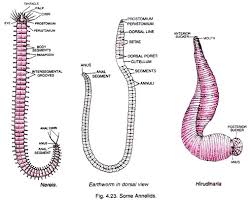Phylum Annelida
1. Their body is metameric, bilaterally symmetrical, and wormlike.
2. They show protostome characteristics include spiral cleavage, trochophore larvae and schizocoelous coelom formation.
3. They have paired epidermal setae.
4. They have closed circulatory system.
5. They have dorsal supra pharyngeal ganglia and ventral nerve cords with ganglia.
Phylum annelida have three classes:
1. Class Polychaeta
1. It is largest annelid class.
2. They are mostly marine.
3. They develop head with eyes and tentacles.
4. They have parapodia. Numerous setae are present in parapodia.
5. They are monoecious or dioecious. Trochophore larva is developed during embryonic development.
Example: Nereis. Arenicola, Sabella.
2. Class Oligochaeta
1. They have few setae and no parapodia.
2. They have no distinct head.
3. They are monoecious with direct development.
4. They are primarily freshwater or terrestrial. Example: Lumbricus, Tubifex.
3. Class Hirudinea
1. Their body bodies are divided into 34 segments.
2. Each segment is subdivided into annuli.
3. They are anterior and posterior stickers present.
4. They are monoecious with direct development.
5. Parapodia are absent. They are reduced or absent.
6. They are freshwater, marine, and terrestrial.
Example: Hirudo.

